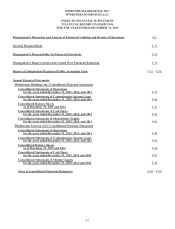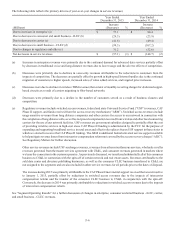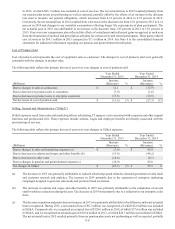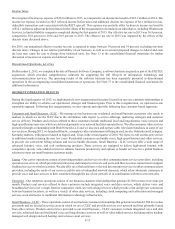Windstream 2015 Annual Report Download - page 136
Download and view the complete annual report
Please find page 136 of the 2015 Windstream annual report below. You can navigate through the pages in the report by either clicking on the pages listed below, or by using the keyword search tool below to find specific information within the annual report.
F-6
The following table reflects the primary drivers of year-over-year changes in service revenues:
Year Ended
December 31, 2015
Year Ended
December 31, 2014
(Millions)
Increase
(Decrease) %
Increase
(Decrease) %
Due to increases in enterprise (a) $ 77.1 $ 84.4
Due to decreases in consumer and small business - ILEC (b) (24.3)(23.9)
Due to decreases in carrier (c) (41.8)(49.4)
Due to decreases in small business - CLEC (d) (99.3)(107.2)
Due to changes in regulatory and other (e) 31.2 (52.6)
Net decreases in service revenues $ (57.1)(1) $ (148.7)(2)
(a) Increases in enterprise revenues were primarily due to the continued demand for advanced data services partially offset
by decreases in traditional voice and long-distance revenues due to lower usage and the adverse effects of competition.
(b) Decreases were primarily due to declines in voice-only revenues attributable to the reductions in customers from the
impacts of competition. The decreases are partially offset by growth in high-speed Internet bundles due to the continued
migration of customers to higher speeds, increased sales of value added services, and targeted price increases.
(c) Decreases were due to declines in wireless TDM revenues that consist of monthly recurring charges for dedicated copper-
based circuits as a result of carriers migrating to fiber-based networks.
(d) Decreases were primarily due to a decline in the number of customers served as a result of business closures and
competition.
(e) Regulatory revenues include switched access revenues, federal and state Universal Service Fund (“USF”) revenues, CAF
Phase II support, and funds received from the access recovery mechanism (“ARM”). Switched access revenues include
usage sensitive revenues from long distance companies and other carriers for access to our network in connection with
the completion of long distance calls, as well as reciprocal compensation received from wireless and other local connecting
carriers for the use of our network facilities. USF revenues are government subsidies designed to partially offset the cost
of providing wireline services in high-cost areas. CAF Phase II funding is administered by the FCC for the purpose of
expanding and supporting broadband service in rural areas and effectively replaces frozen USF support in those states in
which we elected to receive the CAF Phase II funding. The ARM is additional federal universal service support available
to help mitigate revenue losses from intercarrier compensation reform not covered by the access recovery charge (“ARC”).
See Regulatory Matters for further discussion.
Other service revenues include USF surcharge revenues, revenues from other miscellaneous services, wholesale reseller
revenues generated from the master services agreement with CS&L, and consumer revenues generated in markets where
we lease the connection to the customer premise. As previously discussed, we transferred substantially all of this consumer
business to CS&L in connection with the spin-off of certain network and real estate assets. Revenues attributable to the
sold data center and directory publishing businesses, as well as the consumer CLEC business transferred to CS&L are
not assigned to the segments and are also included in other service revenues for all periods prior to the dates of disposal.
The increase during 2015 was primarily attributable to the CAF Phase II incremental support received that was retroactive
to January 1, 2015, partially offset by reductions in switched access revenues due to the impacts of intercarrier
compensation reform and the transfer of the consumer CLEC business to CS&L in conjunction with the spin-off.
Conversely, the decrease in 2014 was primarily attributable to reductions in switched access revenues due to the impacts
of intercarrier compensation reform.
See “Segment Operating Results” for a further discussion of changes in enterprise, consumer and small business - ILEC, carrier,
and small business - CLEC revenues.
























